The Cambridge History of China. Vol. 12: Republican China, 1912-1949, Part 1
Подождите немного. Документ загружается.

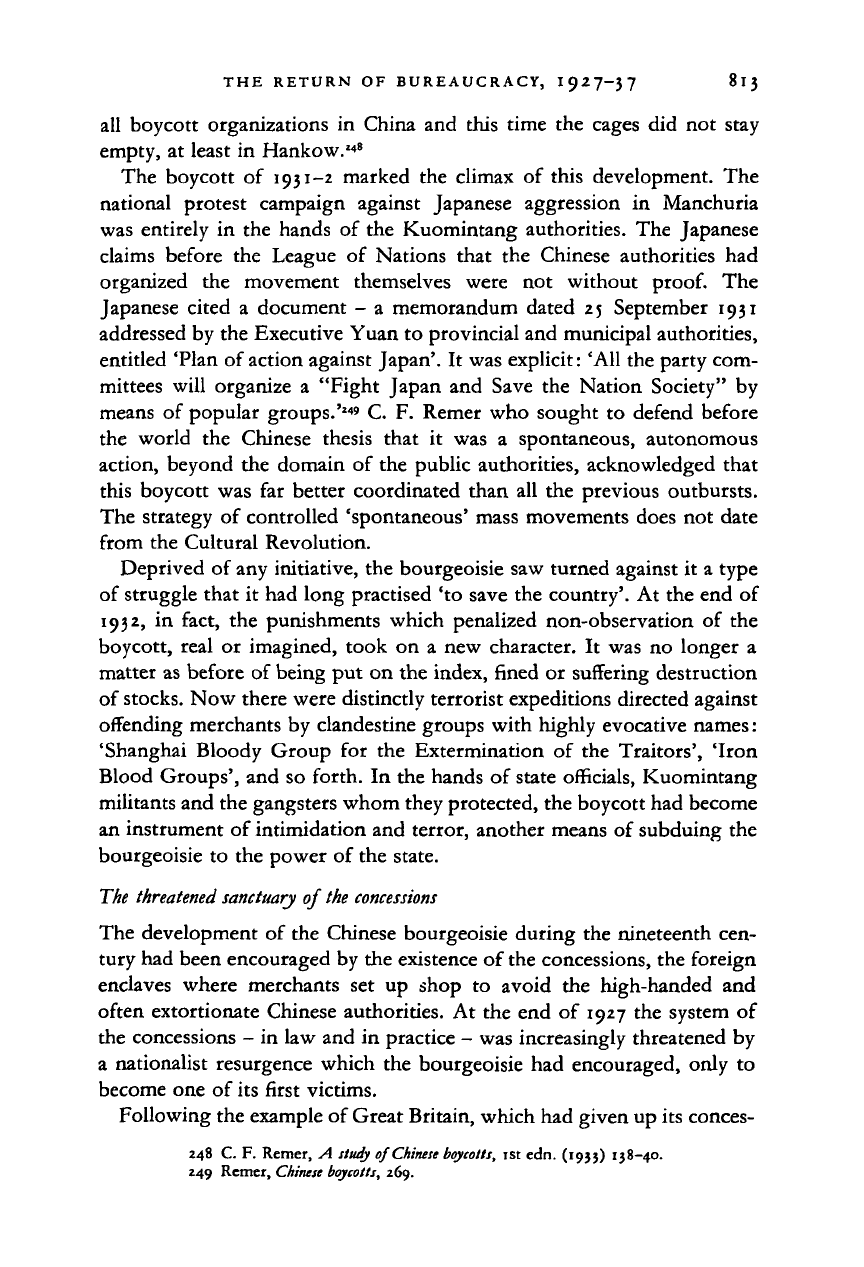
THE RETURN OF BUREAUCRACY,
I 9 2
7-3
7
813
all boycott organizations in China and this time the cages did not stay
empty, at least in Hankow.
2
"
8
The boycott of 1931-2 marked the climax of this development. The
national protest campaign against Japanese aggression in Manchuria
was entirely in the hands of the Kuomintang authorities. The Japanese
claims before the League of Nations that the Chinese authorities had
organized the movement themselves were not without
proof.
The
Japanese cited a document - a memorandum dated 25 September 1931
addressed by the Executive Yuan to provincial and municipal authorities,
entitled 'Plan of action against Japan'. It was explicit: 'All the party com-
mittees will organize a "Fight Japan and Save the Nation Society" by
means of popular groups.'
249
C. F. Remer who sought to defend before
the world the Chinese thesis that it was a spontaneous, autonomous
action, beyond the domain of the public authorities, acknowledged that
this boycott was far better coordinated than all the previous outbursts.
The strategy of controlled 'spontaneous' mass movements does not date
from the Cultural Revolution.
Deprived of any initiative, the bourgeoisie saw turned against it a type
of struggle that it had long practised 'to save the country'. At the end of
1932,
in fact, the punishments which penalized non-observation of the
boycott, real or imagined, took on a new character. It was no longer a
matter as before of being put on the index, fined or suffering destruction
of
stocks.
Now there were distinctly terrorist expeditions directed against
offending merchants by clandestine groups with highly evocative names:
'Shanghai Bloody Group for the Extermination of the Traitors', 'Iron
Blood Groups', and so forth. In the hands of state officials, Kuomintang
militants and the gangsters whom they protected, the boycott had become
an instrument of intimidation and terror, another means of subduing the
bourgeoisie to the power of the state.
The threatened sanctuary of the concessions
The development of the Chinese bourgeoisie during the nineteenth cen-
tury had been encouraged by the existence of the concessions, the foreign
enclaves where merchants set up shop to avoid the high-handed and
often extortionate Chinese authorities. At the end of 1927 the system of
the concessions - in law and in practice - was increasingly threatened by
a nationalist resurgence which the bourgeoisie had encouraged, only to
become one of its first victims.
Following the example of Great Britain, which had given up its conces-
248 C. F. Remer, A study of
Chinese
boycotts,
ist edn. (1933) 138-40.
249
Remer,
Chinese
boycotts,
269.
Cambridge Histories Online © Cambridge University Press, 2008
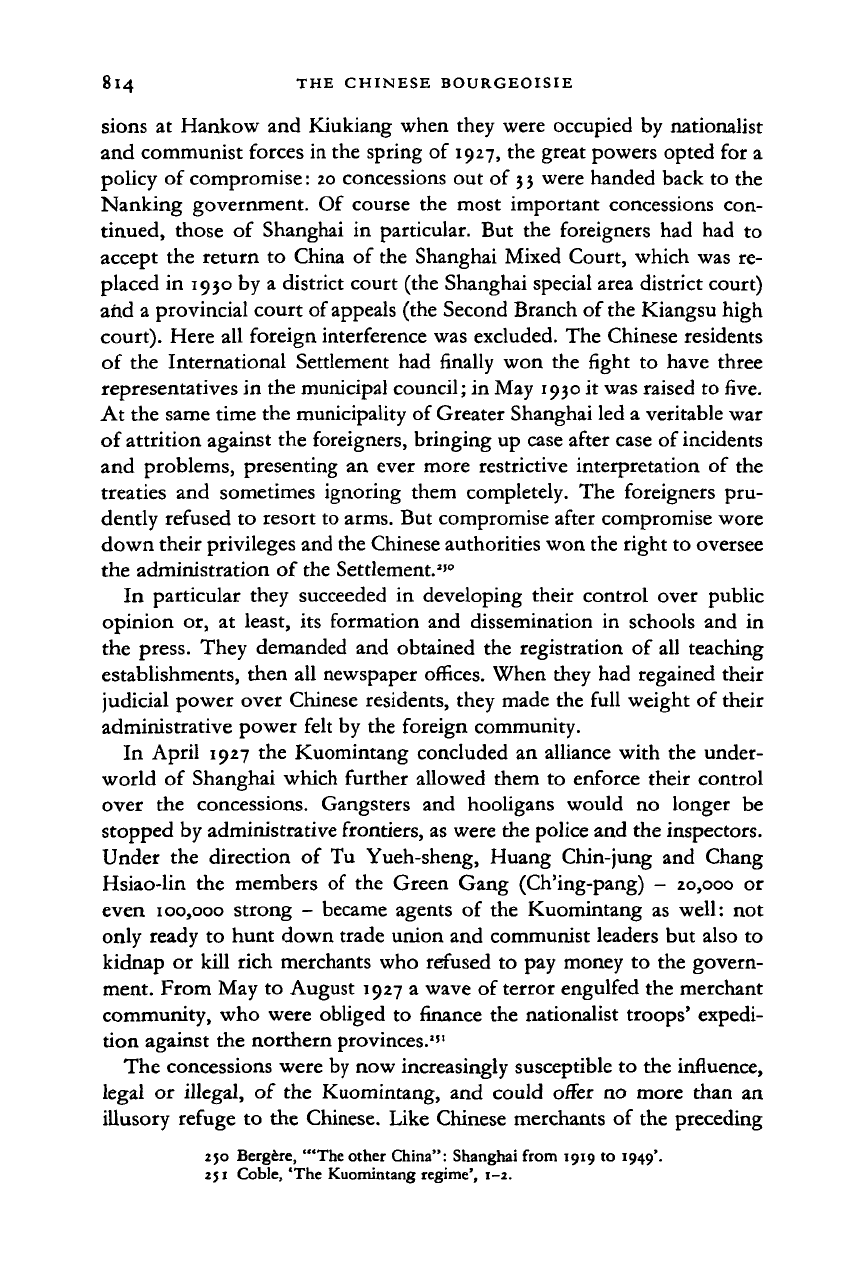
814 THE CHINESE BOURGEOISIE
sions
at
Hankow
and
Kiukiang when they were occupied
by
nationalist
and communist forces in the spring
of
1927,
the
great powers opted
for a
policy
of
compromise: 20 concessions
out of
3 3
were handed back
to the
Nanking government.
Of
course
the
most important concessions
con-
tinued, those
of
Shanghai
in
particular.
But the
foreigners
had had to
accept
the
return
to
China
of
the Shanghai Mixed Court, which
was re-
placed
in
1930
by a
district court (the Shanghai special area district court)
and
a
provincial court of appeals (the Second Branch
of
the Kiangsu high
court).
Here
all
foreign interference was excluded.
The
Chinese residents
of
the
International Settlement
had
finally
won the
fight
to
have three
representatives
in
the municipal council;
in
May 1930
it
was raised
to
five.
At the same time the municipality
of
Greater Shanghai led
a
veritable war
of attrition against
the
foreigners, bringing
up
case after case
of
incidents
and problems, presenting
an
ever more restrictive interpretation
of the
treaties
and
sometimes ignoring them completely.
The
foreigners
pru-
dently refused
to
resort to arms. But compromise after compromise wore
down their privileges and the Chinese authorities won the right to oversee
the administration
of
the Settlement.
2
'
0
In particular they succeeded
in
developing their control over public
opinion
or, at
least,
its
formation
and
dissemination
in
schools
and in
the press. They demanded
and
obtained
the
registration
of all
teaching
establishments, then
all
newspaper offices. When they
had
regained their
judicial power over Chinese residents, they made
the
full weight
of
their
administrative power felt
by the
foreign community.
In April 1927
the
Kuomintang concluded
an
alliance with
the
under-
world
of
Shanghai which further allowed them
to
enforce their control
over
the
concessions. Gangsters
and
hooligans would
no
longer
be
stopped by administrative frontiers, as were the police and the inspectors.
Under
the
direction
of Tu
Yueh-sheng, Huang Chin-jung
and
Chang
Hsiao-lin
the
members
of the
Green Gang (Ch'ing-pang)
-
20,000
or
even 100,000 strong
-
became agents
of the
Kuomintang
as
well:
not
only ready
to
hunt down trade union
and
communist leaders
but
also
to
kidnap
or
kill rich merchants
who
refused
to pay
money
to the
govern-
ment. From May
to
August 1927
a
wave
of
terror engulfed the merchant
community,
who
were obliged
to
finance
the
nationalist troops' expedi-
tion against
the
northern provinces.
2
'
1
The concessions were by now increasingly susceptible
to
the influence,
legal
or
illegal,
of the
Kuomintang,
and
could offer
no
more than
an
illusory refuge
to the
Chinese. Like Chinese merchants
of
the preceding
250 Bergere, '"The other China": Shanghai from 1919
to
1949'.
251 Gable, 'The Kuomintang regime',
1-2.
Cambridge Histories Online © Cambridge University Press, 2008
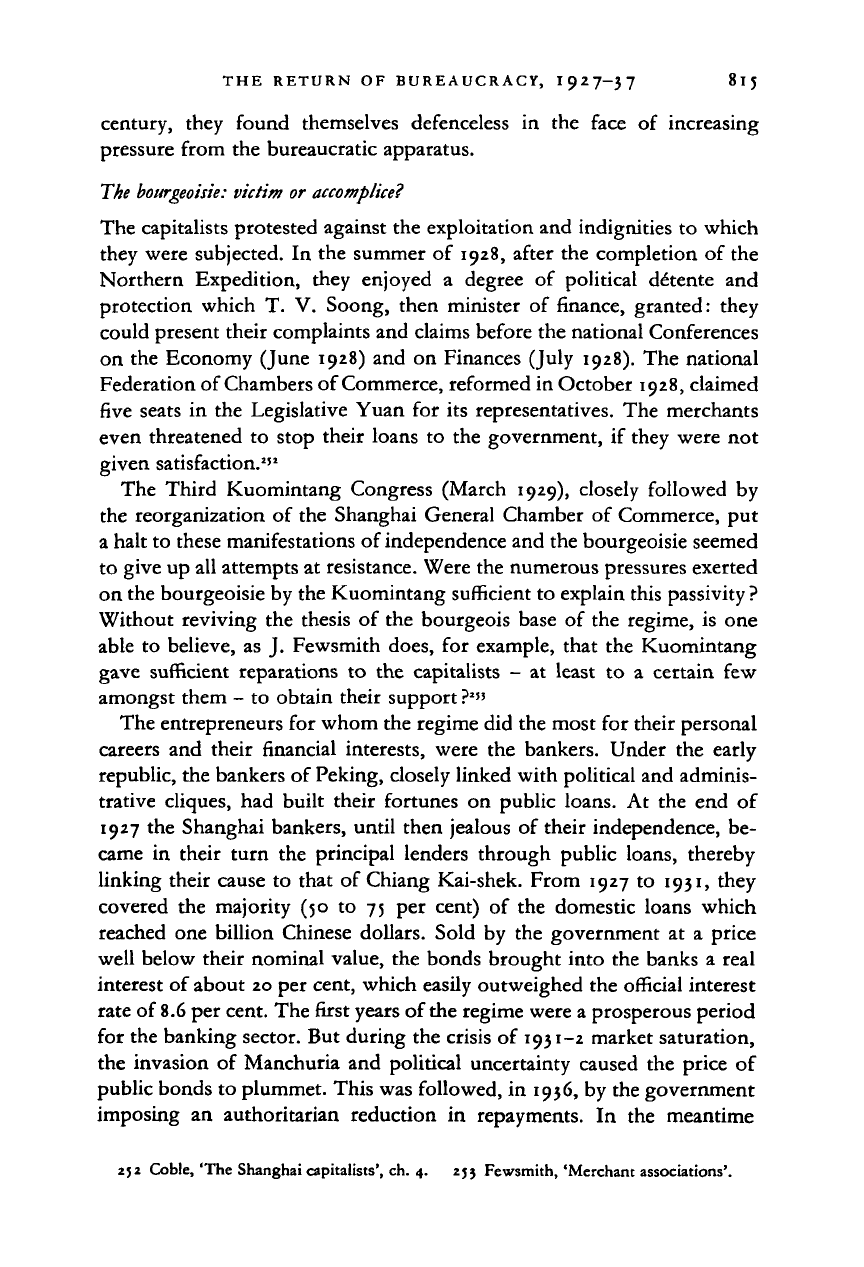
THE RETURN OF BUREAUCRACY,
I 9 2
7-3
7
815
century, they found themselves defenceless in the face of increasing
pressure from the bureaucratic apparatus.
The bourgeoisie: victim or accomplice?
The capitalists protested against the exploitation and indignities to which
they were subjected. In the summer of 1928, after the completion of the
Northern Expedition, they enjoyed a degree of political detente and
protection which T. V. Soong, then minister of finance, granted: they
could present their complaints and claims before the national Conferences
on the Economy (June 1928) and on Finances (July 1928). The national
Federation of Chambers of
Commerce,
reformed in October 1928, claimed
five seats in the Legislative Yuan for its representatives. The merchants
even threatened to stop their loans to the government, if they were not
given satisfaction.
2
'
1
The Third Kuomintang Congress (March 1929), closely followed by
the reorganization of the Shanghai General Chamber of Commerce, put
a halt to these manifestations of independence and the bourgeoisie seemed
to give up all attempts at resistance. Were the numerous pressures exerted
on the bourgeoisie by the Kuomintang sufficient to explain this passivity ?
Without reviving the thesis of the bourgeois base of the regime, is one
able to believe, as J. Fewsmith does, for example, that the Kuomintang
gave sufficient reparations to the capitalists - at least to a certain few
amongst them - to obtain their support ?
2
»
The entrepreneurs for whom the regime did the most for their personal
careers and their financial interests, were the bankers. Under the early
republic, the bankers of Peking, closely linked with political and adminis-
trative cliques, had built their fortunes on public loans. At the end of
1927 the Shanghai bankers, until then jealous of their independence, be-
came in their turn the principal lenders through public loans, thereby
linking their cause to that of Chiang Kai-shek. From 1927 to 1931, they
covered the majority (50 to 75 per cent) of the domestic loans which
reached one billion Chinese dollars. Sold by the government at a price
well below their nominal value, the bonds brought into the banks a real
interest of about 20 per cent, which easily outweighed the official interest
rate of 8.6 per cent. The first years of the regime were a prosperous period
for the banking sector. But during the crisis of 1931-2 market saturation,
the invasion of Manchuria and political uncertainty caused the price of
public bonds to plummet. This was followed, in 1936, by the government
imposing an authoritarian reduction in repayments. In the meantime
252 Coble, 'The Shanghai capitalists', ch. 4. 25) Fewsmith, 'Merchant associations'.
Cambridge Histories Online © Cambridge University Press, 2008
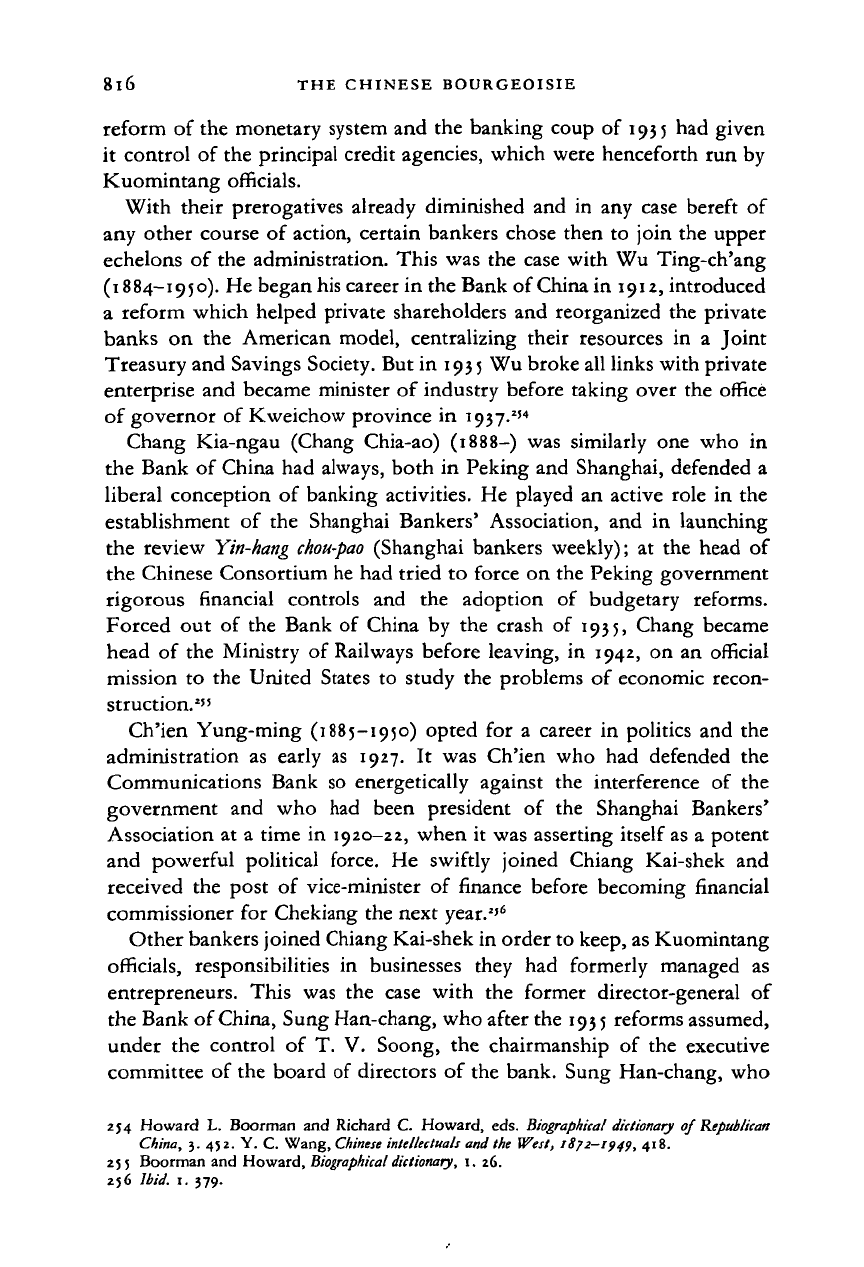
8l6 THE CHINESE BOURGEOISIE
reform of the monetary system and the banking coup
of
1935 had given
it control
of
the principal credit agencies, which were henceforth run by
Kuomintang officials.
With their prerogatives already diminished and
in
any case bereft
of
any other course
of
action, certain bankers chose then to join the upper
echelons
of
the administration. This was the case with Wu Ting-ch'ang
(1884-1950). He began his career in the Bank of China in 1912, introduced
a reform which helped private shareholders and reorganized the private
banks
on the
American model, centralizing their resources
in a
Joint
Treasury and Savings Society. But in 1935 Wu broke all links with private
enterprise and became minister
of
industry before taking over the office
of governor of Kweichow province in 1937.
2
'
4
Chang Kia-ngau (Chang Chia-ao) (1888-) was similarly one who
in
the Bank of China had always, both in Peking and Shanghai, defended
a
liberal conception
of
banking activities. He played an active role
in
the
establishment
of
the Shanghai Bankers' Association, and
in
launching
the review
Yin-hang chou-pao
(Shanghai bankers weekly);
at
the head
of
the Chinese Consortium he had tried to force on the Peking government
rigorous financial controls
and the
adoption
of
budgetary reforms.
Forced out
of
the Bank
of
China
by
the crash
of
1935, Chang became
head
of
the Ministry
of
Railways before leaving,
in
1942, on an official
mission
to
the United States
to
study the problems
of
economic recon-
struction.
2
"
Ch'ien Yung-ming (1885-1950) opted
for a
career
in
politics and the
administration
as
early
as
1927.
It
was Ch'ien who
had
defended
the
Communications Bank so energetically against
the
interference
of the
government
and who had
been president
of the
Shanghai Bankers'
Association at
a
time
in
1920-22, when
it
was asserting itself as
a
potent
and powerful political force.
He
swiftly joined Chiang Kai-shek
and
received the post
of
vice-minister
of
finance before becoming financial
commissioner for Chekiang the next year.
2
'
6
Other bankers joined Chiang Kai-shek in order to keep, as Kuomintang
officials, responsibilities
in
businesses they
had
formerly managed
as
entrepreneurs. This was
the
case with
the
former director-general
of
the Bank of
China,
Sung Han-chang, who after the 1935 reforms assumed,
under
the
control
of T. V.
Soong, the chairmanship
of
the executive
committee
of
the board
of
directors
of
the bank. Sung Han-chang, who
254 Howard
L.
Boorman and Richard
C.
Howard, eds. Biographical
dictionary
of
Republican
China, 3. 452. Y. C. Wang,
Chinese intellectuals
and the West, 1H72-1949, 418.
255 Boorman and Howard,
Biographical
dictionary,
1.
26.
256
Ibid.
1.
379.
Cambridge Histories Online © Cambridge University Press, 2008
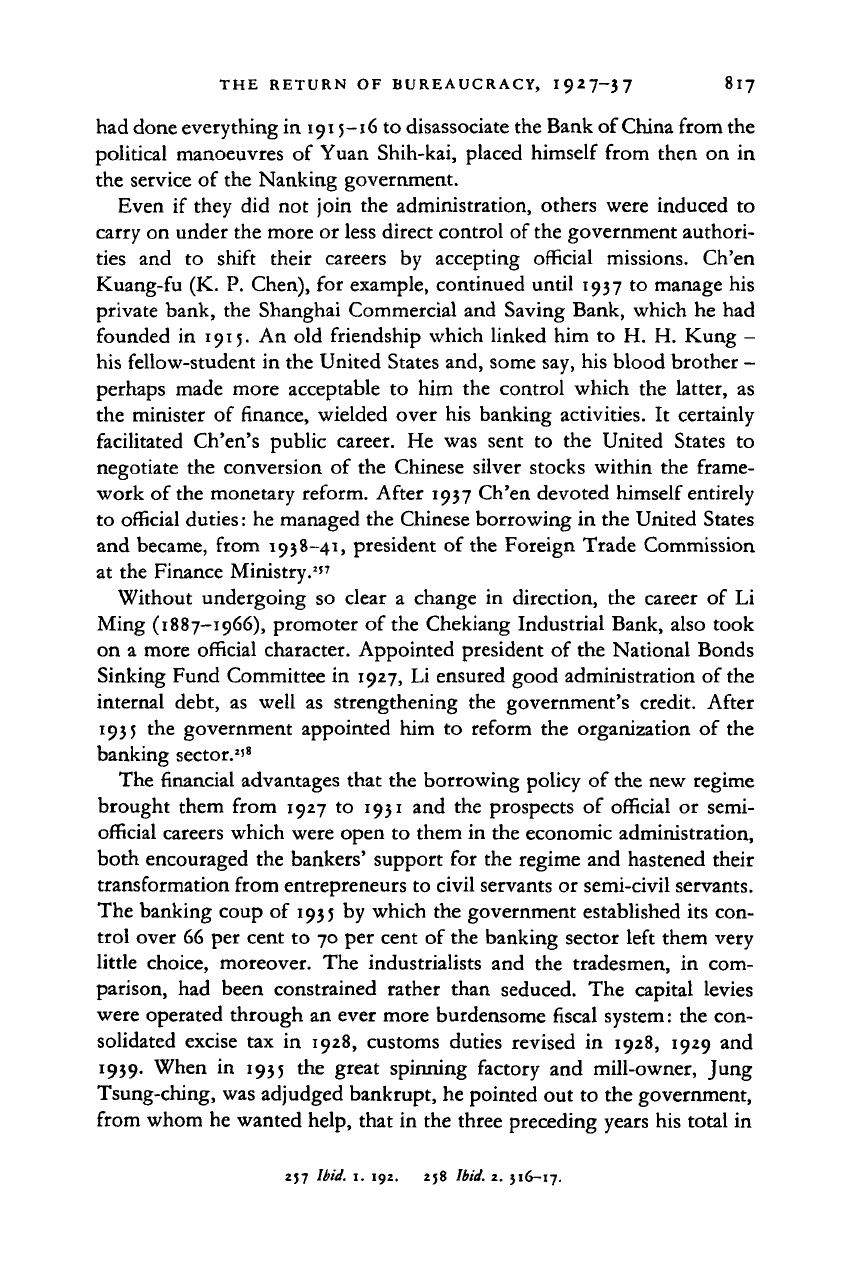
THE RETURN OF BUREAUCRACY,
I 9 2
7-3 7
817
had done everything
in
1915-16
to
disassociate the Bank
of
China from the
political manoeuvres
of
Yuan Shih-kai, placed himself from then
on in
the service
of
the Nanking government.
Even
if
they
did not
join
the
administration, others were induced
to
carry
on
under
the
more
or
less direct control
of
the government authori-
ties
and to
shift their careers
by
accepting official missions. Ch'en
Kuang-fu
(K. P.
Chen),
for
example, continued until 1937
to
manage
his
private bank,
the
Shanghai Commercial
and
Saving Bank, which
he had
founded
in
1915.
An old
friendship which linked
him to H. H.
Kung
-
his fellow-student
in
the United States and, some say,
his
blood brother
-
perhaps made more acceptable
to him the
control which
the
latter,
as
the minister
of
finance, wielded over
his
banking activities.
It
certainly
facilitated Ch'en's public career.
He was
sent
to the
United States
to
negotiate
the
conversion
of the
Chinese silver stocks within
the
frame-
work
of
the monetary reform. After 1937 Ch'en devoted himself entirely
to official duties:
he
managed
the
Chinese borrowing
in the
United States
and became, from
1938-41,
president
of
the Foreign Trade Commission
at
the
Finance Ministry.
2
'
7
Without undergoing
so
clear
a
change
in
direction,
the
career
of Li
Ming (1887-1966), promoter
of
the Chekiang Industrial Bank, also took
on
a
more official character. Appointed president
of the
National Bonds
Sinking Fund Committee
in
1927,
Li
ensured good administration
of
the
internal debt,
as
well
as
strengthening
the
government's credit. After
1935
the
government appointed
him to
reform
the
organization
of the
banking sector.
2
'
8
The financial advantages that
the
borrowing policy
of
the
new
regime
brought them from
1927 to 1931 and the
prospects
of
official
or
semi-
official careers which were open
to
them
in the
economic administration,
both encouraged
the
bankers' support
for the
regime
and
hastened their
transformation from entrepreneurs
to
civil servants
or
semi-civil servants.
The banking coup
of
1935
by
which
the
government established
its con-
trol over
66 per
cent
to 70 per
cent
of
the banking sector left them very
little choice, moreover.
The
industrialists
and the
tradesmen,
in com-
parison,
had
been constrained rather than seduced.
The
capital levies
were operated through
an
ever more burdensome fiscal system:
the con-
solidated excise
tax in 1928,
customs duties revised
in 1928, 1929 and
1939.
When
in 1935 the
great spinning factory
and
mill-owner, Jung
Tsung-ching, was adjudged bankrupt,
he
pointed
out to
the government,
from whom
he
wanted help, that
in the
three preceding years
his
total
in
257
Ibid.
1. 192. 258
Ibid.
2.
316-17.
Cambridge Histories Online © Cambridge University Press, 2008
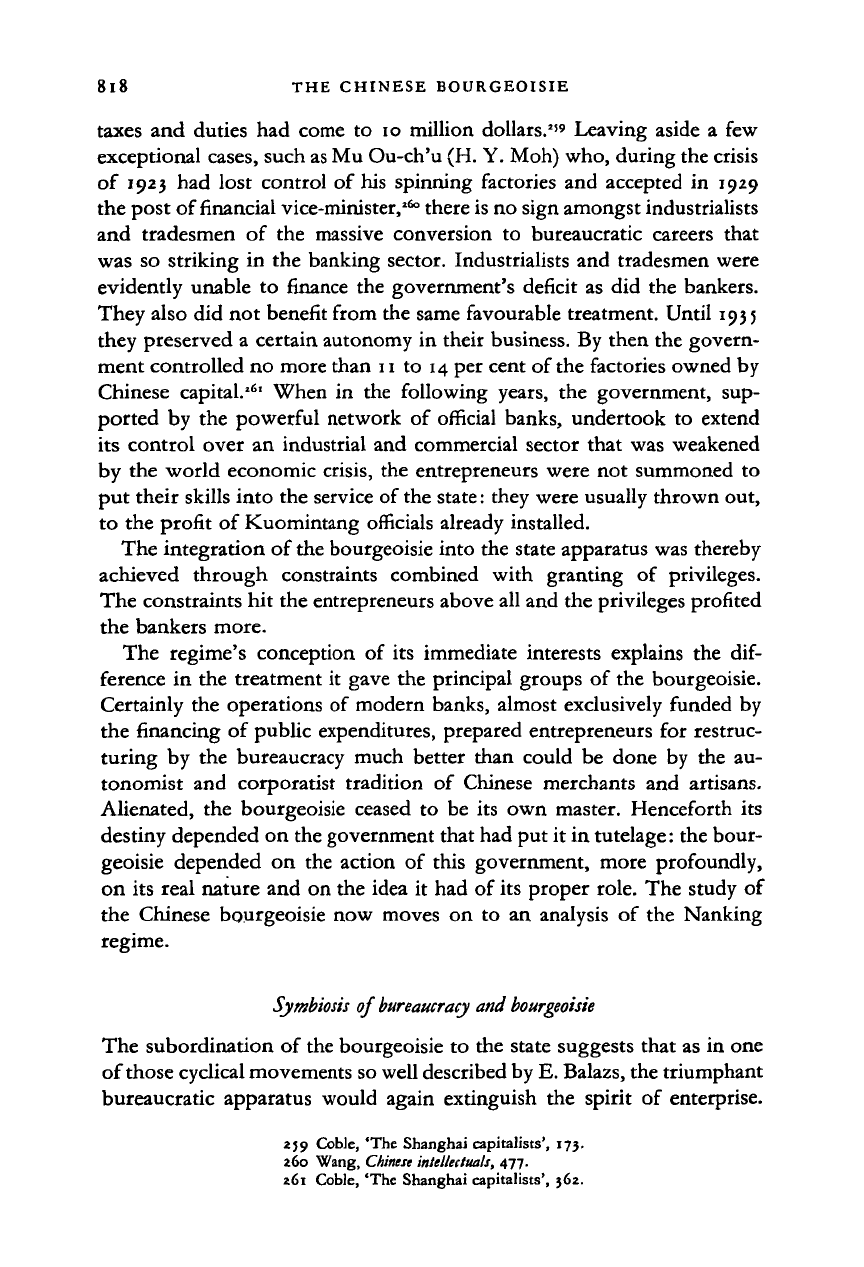
8l8 THE CHINESE BOURGEOISIE
taxes
and
duties
had
come
to 10
million dollars.
2
'
9
Leaving aside
a few
exceptional cases, such as Mu Ou-ch'u (H. Y. Moh) who, during the crisis
of 1923
had
lost control
of
his spinning factories
and
accepted
in 1929
the post
of
financial vice-minister,
260
there is no sign amongst industrialists
and tradesmen
of the
massive conversion
to
bureaucratic careers that
was
so
striking
in the
banking sector. Industrialists
and
tradesmen were
evidently unable
to
finance
the
government's deficit
as did the
bankers.
They also
did not
benefit from the same favourable treatment. Until 1935
they preserved
a
certain autonomy
in
their business.
By
then the govern-
ment controlled
no
more than 11
to
14 per cent
of
the factories owned
by
Chinese capital.
26
' When
in the
following years,
the
government,
sup-
ported
by the
powerful network
of
official banks, undertook
to
extend
its control over
an
industrial
and
commercial sector that
was
weakened
by
the
world economic crisis,
the
entrepreneurs were
not
summoned
to
put their skills into the service
of
the state: they were usually thrown out,
to
the
profit
of
Kuomintang officials already installed.
The integration
of
the bourgeoisie into the state apparatus was thereby
achieved through constraints combined with granting
of
privileges.
The constraints
hit
the entrepreneurs above all and the privileges profited
the bankers more.
The regime's conception
of its
immediate interests explains
the dif-
ference
in the
treatment
it
gave
the
principal groups
of
the bourgeoisie.
Certainly
the
operations
of
modern banks, almost exclusively funded
by
the financing
of
public expenditures, prepared entrepreneurs
for
restruc-
turing
by the
bureaucracy much better than could
be
done
by the au-
tonomist
and
corporatist tradition
of
Chinese merchants
and
artisans.
Alienated,
the
bourgeoisie ceased
to be its own
master. Henceforth
its
destiny depended
on
the government that had put
it in
tutelage: the bour-
geoisie depended
on the
action
of
this government, more profoundly,
on
its
real nature
and on
the idea
it had of
its proper role.
The
study
of
the Chinese bourgeoisie
now
moves
on to an
analysis
of the
Nanking
regime.
Symbiosis of bureaucracy and bourgeoisie
The subordination
of
the bourgeoisie
to the
state suggests that
as in one
of those cyclical movements so well described by E. Balazs, the triumphant
bureaucratic apparatus would again extinguish
the
spirit
of
enterprise.
259 Coble, 'The Shanghai capitalists',
173.
260 Wang,
Chinese
intellectuals,
477.
261 Coble,
'The
Shanghai capitalists',
362.
Cambridge Histories Online © Cambridge University Press, 2008
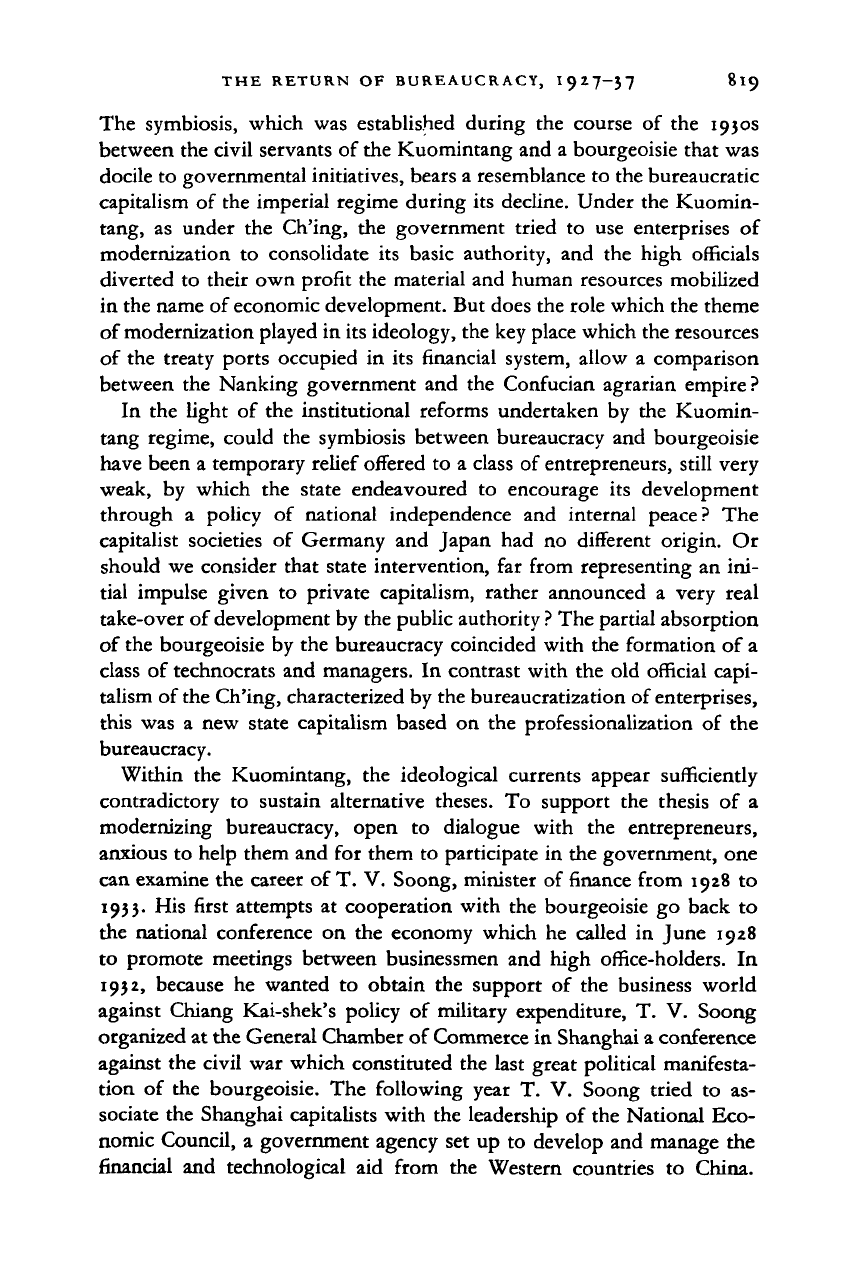
THE RETURN OF BUREAUCRACY,
I 9 2
7-3
7
819
The symbiosis, which was established during the course of the 1930s
between the civil servants of the Kuomintang and a bourgeoisie that was
docile to governmental initiatives, bears a resemblance to the bureaucratic
capitalism of the imperial regime during its decline. Under the Kuomin-
tang, as under the Ch'ing, the government tried to use enterprises of
modernization to consolidate its basic authority, and the high officials
diverted to their own profit the material and human resources mobilized
in the name of economic development. But does the role which the theme
of modernization played in its ideology, the key place which the resources
of the treaty ports occupied in its financial system, allow a comparison
between the Nanking government and the Confucian agrarian empire?
In the light of the institutional reforms undertaken by the Kuomin-
tang regime, could the symbiosis between bureaucracy and bourgeoisie
have been a temporary relief offered to a class of entrepreneurs, still very
weak, by which the state endeavoured to encourage its development
through a policy of national independence and internal peace? The
capitalist societies of Germany and Japan had no different origin. Or
should we consider that state intervention, far from representing an ini-
tial impulse given to private capitalism, rather announced a very real
take-over of development by the public authority
?
The partial absorption
of the bourgeoisie by the bureaucracy coincided with the formation of a
class of technocrats and managers. In contrast with the old official capi-
talism of the Ch'ing, characterized by the bureaucratization of enterprises,
this was a new state capitalism based on the professionalization of the
bureaucracy.
Within the Kuomintang, the ideological currents appear sufficiently
contradictory to sustain alternative theses. To support the thesis of a
modernizing bureaucracy, open to dialogue with the entrepreneurs,
anxious to help them and for them to participate in the government, one
can examine the career of T. V. Soong, minister of finance from 1928 to
1933.
His first attempts at cooperation with the bourgeoisie go back to
the national conference on the economy which he called in June 1928
to promote meetings between businessmen and high office-holders. In
1932,
because he wanted to obtain the support of the business world
against Chiang Kai-shek's policy of military expenditure, T. V. Soong
organized at the General Chamber of Commerce in Shanghai a conference
against the civil war which constituted the last great political manifesta-
tion of the bourgeoisie. The following year T. V. Soong tried to as-
sociate the Shanghai capitalists with the leadership of the National Eco-
nomic Council, a government agency set up to develop and manage the
financial and technological aid from the Western countries to China.
Cambridge Histories Online © Cambridge University Press, 2008
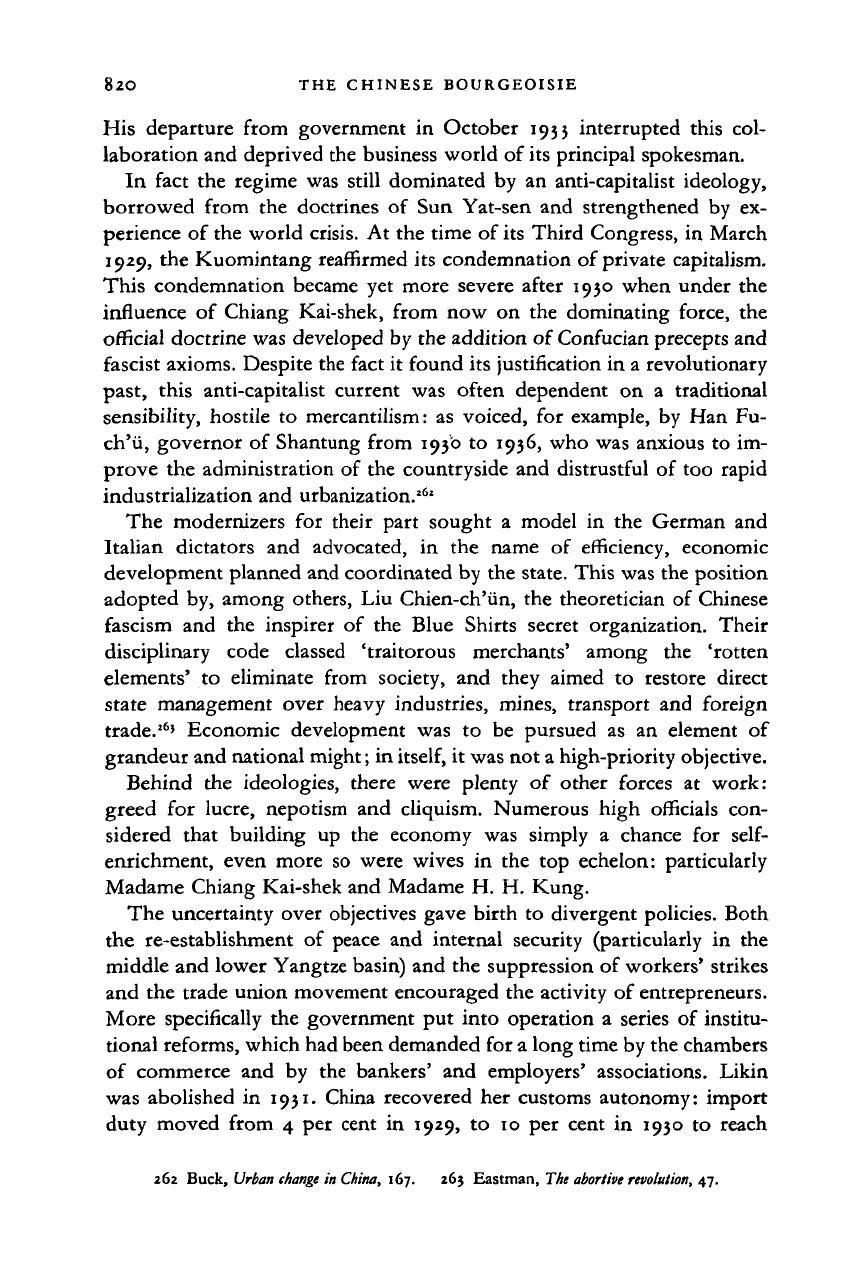
82O THE CHINESE BOURGEOISIE
His departure from government
in
October
1933
interrupted this
col-
laboration
and
deprived
the
business world
of
its
principal spokesman.
In fact
the
regime
was
still dominated
by an
anti-capitalist ideology,
borrowed from
the
doctrines
of Sun
Yat-sen
and
strengthened
by ex-
perience
of
the
world crisis.
At the
time
of
its
Third Congress,
in
March
1929,
the
Kuomintang reaffirmed
its
condemnation
of
private capitalism.
This condemnation became
yet
more severe after
1930
when under
the
influence
of
Chiang Kai-shek, from
now on the
dominating force,
the
official doctrine
was
developed
by
the
addition
of
Confucian precepts
and
fascist axioms. Despite
the
fact
it
found
its
justification
in a
revolutionary
past, this anti-capitalist current
was
often dependent
on a
traditional
sensibility, hostile
to
mercantilism:
as
voiced,
for
example,
by Han Fu-
ch'ii,
governor
of
Shantung from
1930
to
1936, who was
anxious
to im-
prove
the
administration
of the
countryside
and
distrustful
of
too
rapid
industrialization
and
urbanization.
262
The modernizers
for
their part sought
a
model
in the
German
and
Italian dictators
and
advocated,
in the
name
of
efficiency, economic
development planned
and
coordinated
by the
state. This
was the
position
adopted
by,
among others,
Liu
Chien-ch'iin,
the
theoretician
of
Chinese
fascism
and the
inspirer
of the
Blue Shirts secret organization. Their
disciplinary code classed 'traitorous merchants' among
the
'rotten
elements'
to
eliminate from society,
and
they aimed
to
restore direct
state management over heavy industries, mines, transport
and
foreign
trade.
26
' Economic development
was to be
pursued
as an
element
of
grandeur
and
national might;
in itself,
it
was not a
high-priority objective.
Behind
the
ideologies, there were plenty
of
other forces
at
work:
greed
for
lucre, nepotism
and
cliquism. Numerous high officials
con-
sidered that building
up the
economy
was
simply
a
chance
for
self-
enrichment, even more
so
were wives
in the top
echelon: particularly
Madame Chiang Kai-shek
and
Madame
H. H.
Kung.
The uncertainty over objectives gave birth
to
divergent policies. Both
the re-establishment
of
peace
and
internal security (particularly
in the
middle
and
lower Yangtze basin)
and the
suppression
of
workers' strikes
and
the
trade union movement encouraged
the
activity
of
entrepreneurs.
More specifically
the
government
put
into operation
a
series
of
institu-
tional reforms, which
had
been demanded
for
a
long time
by the
chambers
of commerce
and by the
bankers'
and
employers' associations. Likin
was abolished
in
1931.
China recovered
her
customs autonomy: import
duty moved from
4 per
cent
in
1929,
to 10 per
cent
in
1930
to
reach
262 Buck,
Urban change
in
China,
167. 265
Eastman,
The abortive
revolution,
47.
Cambridge Histories Online © Cambridge University Press, 2008
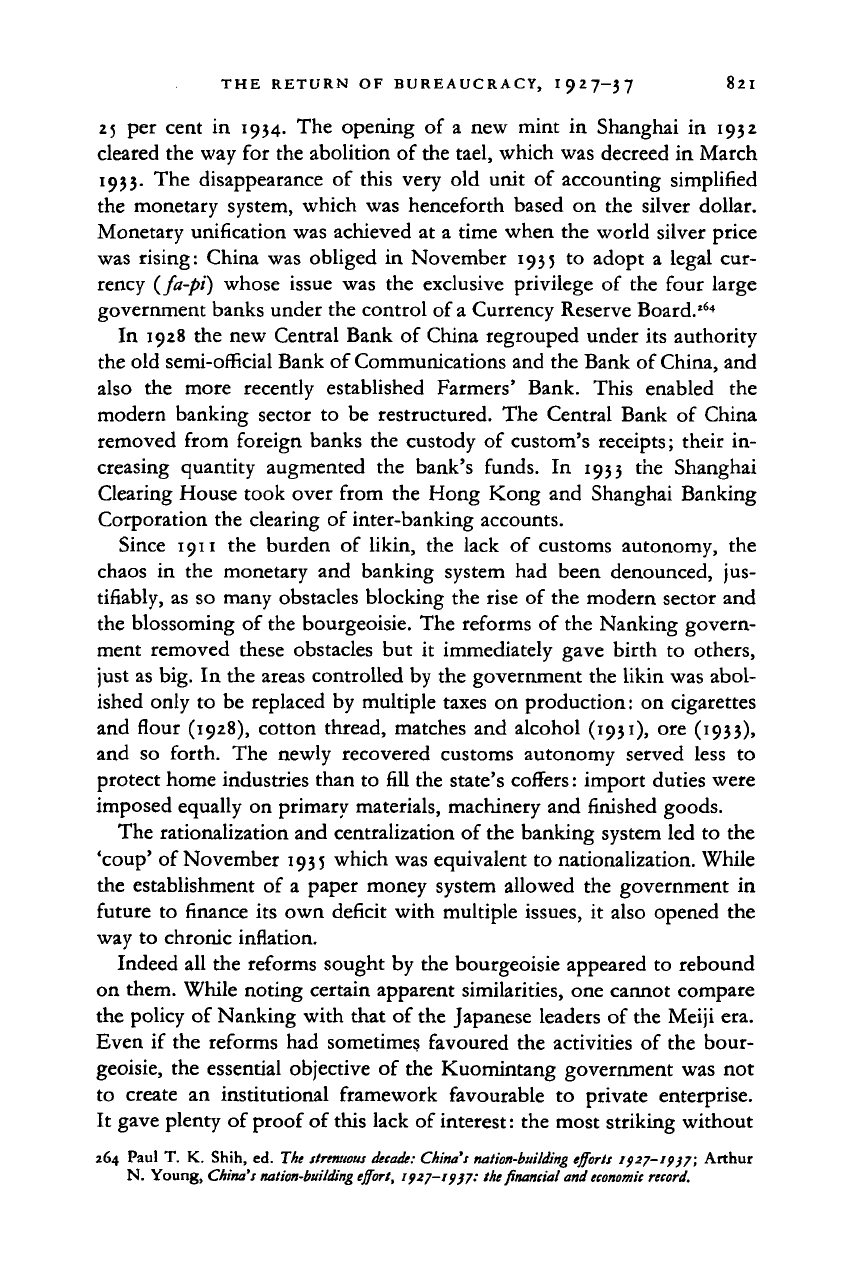
THE RETURN OF BUREAUCRACY,
I 9 2
7-3
7
821
25 per cent in 1934. The opening of a new mint in Shanghai in 1932
cleared the way for the abolition of the tael, which was decreed in March
1933.
The disappearance of this very old unit of accounting simplified
the monetary system, which was henceforth based on the silver dollar.
Monetary unification was achieved at a time when the world silver price
was rising: China was obliged in November 1935 to adopt a legal cur-
rency (fa-pi) whose issue was the exclusive privilege of the four large
government banks under the control of a Currency Reserve Board.*
64
In 1928 the new Central Bank of China regrouped under its authority
the old semi-official Bank of Communications and the Bank of China, and
also the more recently established Farmers' Bank. This enabled the
modern banking sector to be restructured. The Central Bank of China
removed from foreign banks the custody of custom's receipts; their in-
creasing quantity augmented the bank's funds. In 1933 the Shanghai
Clearing House took over from the Hong Kong and Shanghai Banking
Corporation the clearing of inter-banking accounts.
Since 1911 the burden of likin, the lack of customs autonomy, the
chaos in the monetary and banking system had been denounced, jus-
tifiably, as so many obstacles blocking the rise of the modern sector and
the blossoming of the bourgeoisie. The reforms of the Nanking govern-
ment removed these obstacles but it immediately gave birth to others,
just as big. In the areas controlled by the government the likin was abol-
ished only to be replaced by multiple taxes on production: on cigarettes
and flour (1928), cotton thread, matches and alcohol (1931), ore (1933),
and so forth. The newly recovered customs autonomy served less to
protect home industries than to fill the state's coffers: import duties were
imposed equally on primary materials, machinery and finished goods.
The rationalization and centralization of the banking system led to the
'coup'
of November 1935 which was equivalent to nationalization. While
the establishment of a paper money system allowed the government in
future to finance its own deficit with multiple issues, it also opened the
way to chronic inflation.
Indeed all the reforms sought by the bourgeoisie appeared to rebound
on them. While noting certain apparent similarities, one cannot compare
the policy of Nanking with that of the Japanese leaders of the Meiji era.
Even if the reforms had sometimes favoured the activities of the bour-
geoisie, the essential objective of the Kuomintang government was not
to create an institutional framework favourable to private enterprise.
It gave plenty of proof of this lack of interest: the most striking without
264 Paul T. K. Shih, ed. The
strenuous
decade:
China
s
nation-building efforts
1927-19)7; Arthur
N.
Young,
China's nation-building
effort,
1927-19)7: the
financial and economic
record.
Cambridge Histories Online © Cambridge University Press, 2008
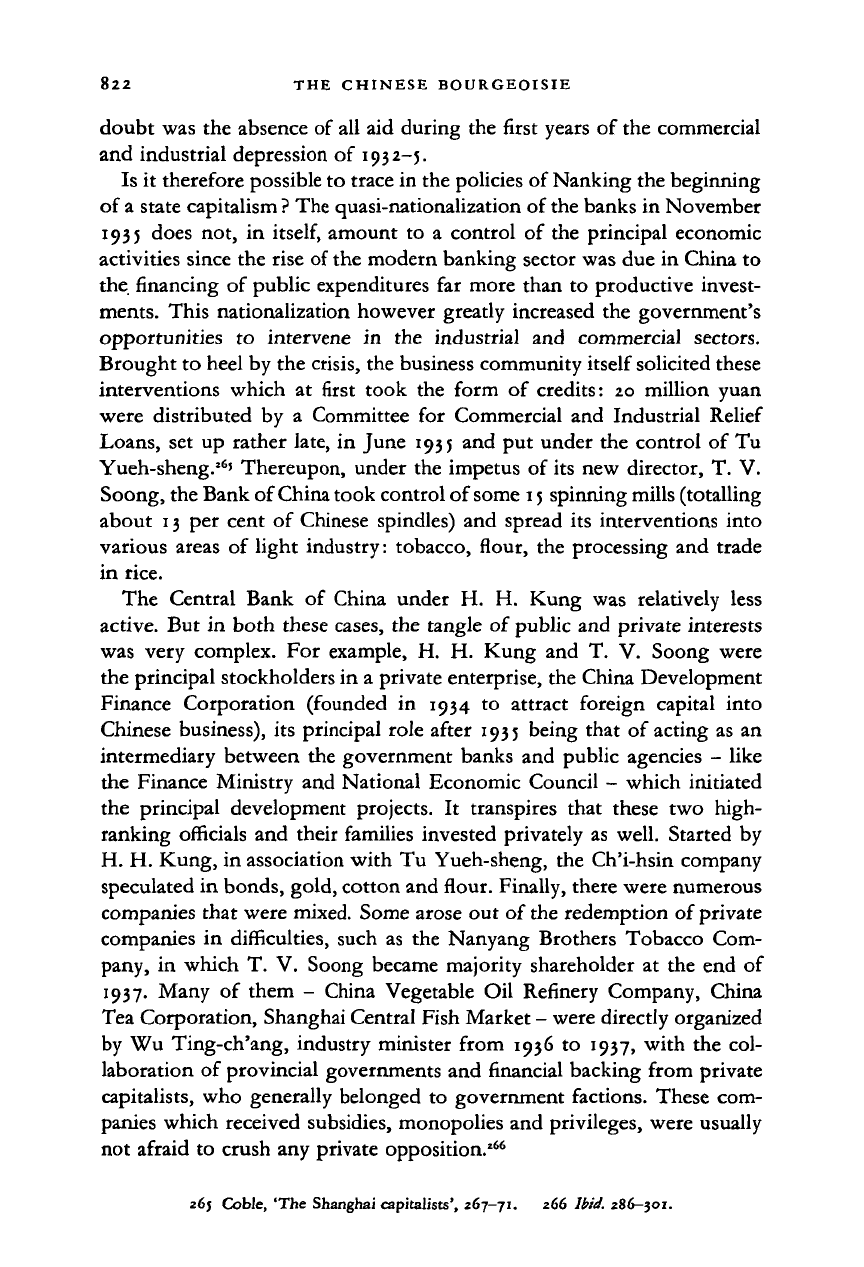
822 THE CHINESE BOURGEOISIE
doubt was
the
absence
of
all
aid
during
the
first years
of
the commercial
and industrial depression
of
1932-5.
Is
it
therefore possible
to
trace
in
the policies
of
Nanking the beginning
of a state capitalism
?
The quasi-nationalization
of
the banks
in
November
1935 does
not, in
itself,
amount
to a
control
of the
principal economic
activities since
the
rise of the modern banking sector was due
in
China
to
the financing
of
public expenditures
far
more than
to
productive invest-
ments. This nationalization however greatly increased
the
government's
opportunities
to
intervene
in the
industrial
and
commercial sectors.
Brought
to
heel
by
the crisis, the business community itself solicited these
interventions which
at
first took
the
form
of
credits:
20
million yuan
were distributed
by a
Committee
for
Commercial
and
Industrial Relief
Loans,
set up
rather late,
in
June 1935
and put
under
the
control
of
Tu
Yueh-sheng.
26
' Thereupon, under
the
impetus
of
its
new
director,
T. V.
Soong, the Bank of China took control
of
some
15
spinning mills (totalling
about
13 per
cent
of
Chinese spindles)
and
spread
its
interventions into
various areas
of
light industry: tobacco, flour,
the
processing
and
trade
in rice.
The Central Bank
of
China under
H. H.
Kung
was
relatively less
active.
But in
both these cases,
the
tangle
of
public
and
private interests
was very complex.
For
example,
H. H.
Kung
and T. V.
Soong were
the principal stockholders
in a
private enterprise,
the
China Development
Finance Corporation (founded
in 1934 to
attract foreign capital into
Chinese business),
its
principal role after 1935 being that
of
acting
as an
intermediary between
the
government banks
and
public agencies
-
like
the Finance Ministry
and
National Economic Council
-
which initiated
the principal development projects.
It
transpires that these
two
high-
ranking officials
and
their families invested privately
as
well. Started
by
H.
H.
Kung,
in
association with
Tu
Yueh-sheng,
the
Ch'i-hsin company
speculated
in
bonds, gold, cotton and flour. Finally, there were numerous
companies that were mixed. Some arose
out of
the redemption
of
private
companies
in
difficulties, such
as the
Nanyang Brothers Tobacco
Com-
pany,
in
which
T. V.
Soong became majority shareholder
at the end of
1937.
Many
of
them
-
China Vegetable
Oil
Refinery Company, China
Tea Corporation, Shanghai Central Fish Market
-
were directly organized
by
Wu
Ting-ch'ang, industry minister from 1936
to
1937, with
the col-
laboration
of
provincial governments
and
financial backing from private
capitalists,
who
generally belonged
to
government factions. These
com-
panies which received subsidies, monopolies
and
privileges, were usually
not afraid
to
crush any private opposition.
266
265 Coble,
'The
Shanghai capitalists', 267-71.
266
Ibid.
286-301.
Cambridge Histories Online © Cambridge University Press, 2008
